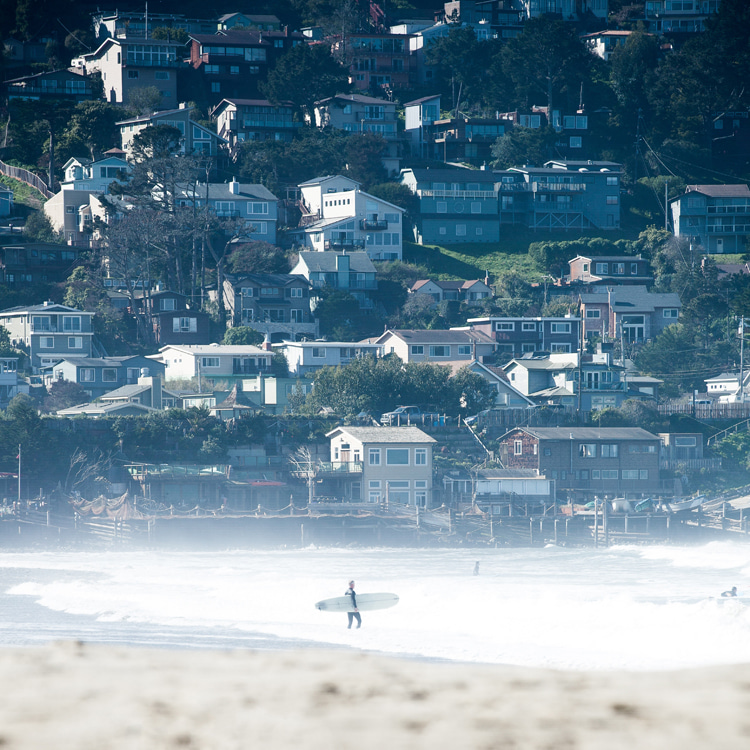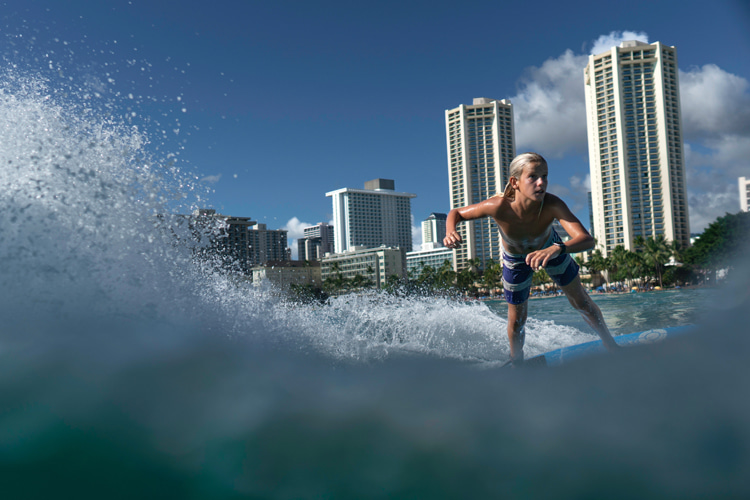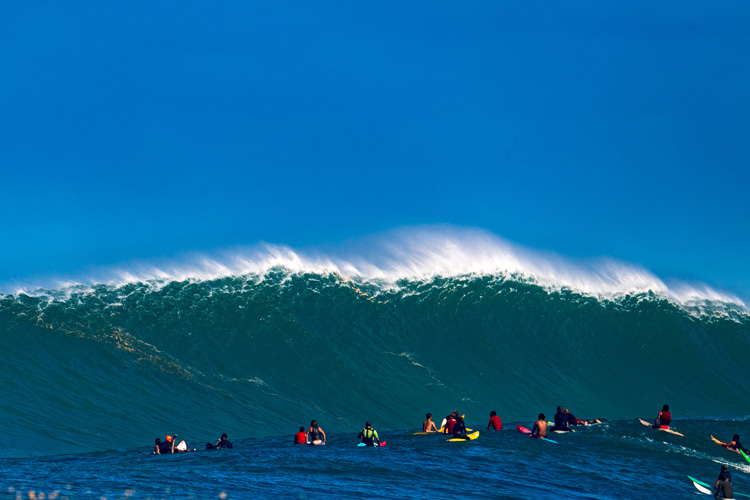Surfing has been growing in popularity for decades, but as it becomes more mainstream, it will face several challenges in the future.
Time flies, and in the year 2,500, this article may be checked for its veracity.
What is surfing going to be like? Will there be robot surfers and personal surf drones capturing each surfer's wave?
For instance, whether provoked by swells, storms, wind, motor crafts, debris, vegetation, coastal management, or human activity, coastal erosion is changing our beaches, waves, and surf spots.
What today might be considered a beach break can easily transform into a point break due to changes in dune sediments.
From overcrowded lineups to the effects of climate change, the main threats that surfing will face in the future include the following:
- Increased competition for waves;
- The need for better management of surf spots;
- The potential impact of rising sea levels;
We usually think that, hopefully, everything's going to be all right, but the wave-riding community has tough challenges ahead.
As surfers and advocates for the sport, it is crucial that we address these issues head-on to ensure the future of surfing for generations to come.
Additionally, there may be unanswered questions related to the development of new technology, such as the potential for electric surfboards, e-foils, and electronic-based surfboards.
Surfers and advocates for the sport must be aware of these challenges and work to address them to keep surfing alive and healthy.
What are the top 10 challenges faced by surfing?
Surfers will encounter three sources of problems - those originating in Nature, man-made interferences, and self-inflicted wounds.
Let's dissect them.

1. Crowded Waves
A common issue regarding surfing is the number of people in the lineup. However, everyone who has ridden waves has gone through it.
With more participants in the water, waves become crowded, and finding an area with good surf and little competition can be challenging.
Crowded lineups are a present and future issue that the sport will likely face in the future due to its growing popularity.
As more and more people take up surfing - in the ocean or wave pools - the number of surfers hassling for waves will proportionally increase, leading to chaotic and anarchic lineups and potential conflicts between fellow wave riders.
Additionally, overcrowding can lead to a decrease in the quality of the waves, as the additional surfers disrupt the natural shape of the wave and reduce the time that each surfer has to enjoy the wave.
Last but not least, in a highly populated lineup, the lack of patience and proper surf etiquette can lead to dangerous situations and conflicts in the water.
The absence - or cancelation - of the informal rule of surfing could be an issue and challenge in the future because of the sport's increasing popularity.
As more people take up wave-riding, fostering an environment of respect, safety, and courtesy in the water becomes important.
Without proper etiquette and safety protocols, surfers can put themselves and others at risk of injury or worse.
Additionally, a lack of etiquette can lead to disputes over wave priority, creating further tension and conflict in the lineup and multiple surf rage events in and out of the water.
2. Coastal Development
As coastal areas become more developed, access to the best surf spots can be restricted.
As a result, some of the world's best surf breaks can be destroyed by construction.
Everyone wants a house with a stunning location overlooking the sea, but shore property owners will also suffer the impact of climate change in the near future.
Actually, overdevelopment can be a threat to the future of surfing in many ways.
It can lead to the destruction of waves, as the construction of buildings and other structures can block the natural formation of waves or change the direction of waves.
Coastal development can also lead to more people using the waves, which can cause overcrowding and lead to a decrease in wave quality.
Additionally, overdevelopment can lead to increased pollution and other environmental degradation, which can have a negative impact on the health of both the waves and the people surfing them.
Marinas have destroyed some of the best surf spots in the world and will continue to do so.
Yachts seem unstoppable when local authorities must decide whether to build or not to build private docks for the wealthy.

3. Poor Water Quality
Water pollution and other contaminants are significant issues when it comes to surfing.
Poor water quality can make it difficult to surf in certain areas and can also hurt marine life.
Unregulated dumping of chemicals and trash into the ocean is a critical threat to the health of ecosystems and affects surfing conditions.
Contaminated waters are an issue that surfing will likely face in the future due to the increasing ocean pollution.
This pollution can come from various sources, such as agricultural runoff, sewage, oil spills, and industrial waste.
As the ocean becomes increasingly polluted, it can become unsafe for surfers to be in contact with these hazardous materials.
Ocean acidification and poor water quality can also destroy coral reefs, which are essential to the health of marine ecosystems and are often popular locations for quality waves and surfing.
The underwater paradise is being destroyed by a powerful underground industry that sells fascinating colored stones to uninformed tourists.
Additionally, pollution has been linked to increased ocean temperatures, which can lead to more frequent and intense storms that can be dangerous for surfers.
Finally, debris and trash can accumulate in the ocean and on beaches, impacting the aesthetics and safety of the area.
4. Climate Change and Rising Sea Levels
The effects of climate change will lead to increased concentrations of pollutants, such as sewage and agricultural runoff, in the ocean.
These pollutants can lead to water-borne diseases and create unhealthy swimming conditions, including an increased risk of skin infections and rashes.
Additionally, the warmer temperatures associated with climate change can lead to algal blooms that are toxic to people and aquatic life.
These algal blooms can make surfing more dangerous, as they can reduce visibility in the water and create hazardous conditions for surfers.
In addition, higher sea levels can lead to more frequent flooding and storm surges, damaging surf breaks, altering the ocean's currents, and making it more difficult for surfers to find good waves.
Sea level rise is changing the way we ride waves. As the Earth warms, glaciers and ice sheets are melting, and seas are rising.
As the water level increases, islands like Hawaii will observe higher seasonal waves, hurricanes, and tsunamis penetrating further inland.

5. Access to Surf Gear
Access to quality surfing equipment can be limited in certain areas.
Access to equipment is a challenge to the future of surfing because it can be limited in certain areas and expensive for people to get it.
Surfboards, wetsuits, and other related gear can be costly and oftentimes require a certain level of skill to use correctly.
The cost of these items can be prohibitive for many people, particularly those from low-income backgrounds or countries where surfing is not as popular.
Additionally, many areas may have limited access to surf shops and other retailers that sell surfing equipment, making it difficult for people to purchase what they need.
6. Unpredictable and Extreme Weather
Weather can have a massive impact on surf conditions. Unpredictable weather patterns can make it difficult to plan for the best days to surf.
Weather conditions are an issue and challenge for surfing in the future because of the potential for more extreme weather due to climate change.
This could lead to more powerful waves, strong winds, higher tides, and more dangerous storm surges.
These conditions could put surfers in danger and lead to more injuries and fatalities.
Additionally, some beaches may be completely destroyed or eroded away due to the increased power of the waves, making it impossible to surf in those areas.
7. Sharks and Other Marine Life
Sharks and other marine life are issues and challenges that surfing will likely face in the future due to the increasing impacts of climate change.
As global temperatures rise, ocean waters are warming, which can change the distribution of certain species.
These changes can lead to an increase in the number of sharks and other creatures in certain areas, which can be a threat to surfers in the water.
Additionally, as ocean waters become more polluted and habitats become more degraded, this can also affect the health of marine life, which can also lead to increased risks for surfers.
As populations of sharks increase due to overfishing and warming waters, shark attacks become more frequent and can be a serious threat to surfers.

8. Changing Ocean Conditions
The ocean is constantly changing, and this can have an effect on the quality of waves and the ability to surf.
Changing ocean conditions present a significant challenge to surfing in the future as they can cause unpredictable and hazardous surf conditions, including more vigorous and frequent storms, rip currents, and higher waves.
Warmer ocean temperatures can also increase the frequency and intensity of tropical storms, which can lead to dangerous surf conditions and put surfers at risk.
Additionally, rising sea levels can affect wave patterns, making waves more powerful and unpredictable, leading to a decrease in wave quality and increasing the difficulty of surfing.
9. Sun Exposure and Skin Aging
Spending too much time in the sun can have a detrimental effect on your health. It is essential to protect your skin and eyes when spending time in the sun and surfing.
Too much sun exposure can lead to skin cancer, dehydration, sunburn, and heat exhaustion.
It can also cause premature skin aging and, in extreme cases, heat stroke.
Long-term exposure to the sun can also damage the eyes and lead to cataracts.
As surfing becomes more popular, surfers will be exposed to the sun for more extended periods, making it more likely that they will suffer from the health effects of too much sun exposure.
10. Rip Currents
Rip currents can pull a surfer away from the shore and have always been a challenge and danger for surfers.
However, as ocean temperatures continue to rise, rip currents are becoming more powerful, and their reach is becoming larger, making them a greater hazard for surfers.
Additionally, as more and more people flock to the beach for recreational activities and surfing, the potential for rip current-related accidents increases.
Therefore, surfers need to be aware of the area and take the necessary precautions when surfing.
Conclusion
Are there solutions for the potential end of surfing?
Low carbon economies and lifestyles, respect for Nature's way, protection of local ecosystems, and wave pools could help.
Though surfing will undoubtedly face challenges in the future, we can remain optimistic that it will continue to thrive and evolve.
With the right dedication and support, new technologies and innovative solutions can help ensure that the sport remains a beloved pastime and cultural symbol.
As surfers, we can continue to protect our oceans, support our local surfing communities, and ensure that future generations can experience the joy of riding waves.
Each one of us has access to the vault that keeps surfing safe.
All we need is to be aware of these threats and work to address them to ensure the future of such a magical outdoor activity.
Words by Andrew Island | Surfer, Skateboarder and Author
